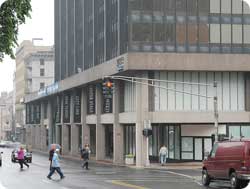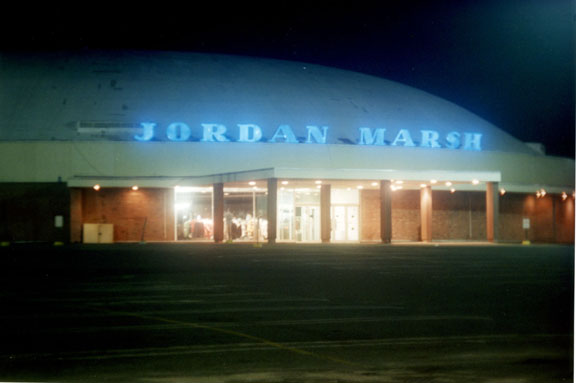

New Haven has long had a bad reputation as a rough and dowdy city. Truth be told, this characterization has always reeked of sour grapes to me–it seemed like the only people talking about how “awful” New Haven is are those Yale students who are maybe just a bit bitter they didn’t get into Harvard. Sure, playing chess in Harvard Square while listening to a hippie blow on a didgeridoo may help get you in an academic mindset, but wouldn’t we all prefer to live in a “real” city where we’re part of the re-urbanization movement? No? Well, forget you then.
Truth be told, poor ‘lil New Haven’s feelings have been hurt numerous times over the years by those sneering Yaleys. During the 1960s and 1970s, which were a truly dreadful era for urban renewal ideas, the city threw its weight behind nearly every failed concept–a civic center! huge parking garages! a massive, concrete bunker-styled mall! a suburban-style office park!–all in the name of making itself just a bit more loveable. Today, these buildings–including the Coliseum, which is currently being demolished–help form a downtown graveyard of concrete tackiness. All those Yale kids didn’t realize that words hurt, man.
One of the most notable projects of that era was the Chapel Square Mall, built right on the edge of the city’s common near the intersection of Chapel and Church Streets. As usual, those scamps over at Deadmalls have a more complete history than I could offer, but this mall had a very strange configuration wherein the anchor stores (a large Macy’s and an Edw. Malley Co.) were each on the two southern blocks (on either side of George Street, along Church St.), and the mall was on the northern block closest to the common. Because the mall spanned three city blocks, it meant that each building had to be skywalked together, but since Macy’s was on the center block, both anchors were at the same end of the mall and it was necessary for Malley’s shoppers to walk through Macy’s to reach the mall.
When I first visited Chapel Square Mall in fall of 1999, it was already in a pretty severe state of decline, and Macy’s was already long gone. The mall itself still hosted a few national chains as well as a bevy of local stores (as detailed in this snarky Yale Herald piece) appealing mainly to an urban clientele, including a large (and seemingly very successful) independent record store focusing on R&B and Hip-Hop. The main mall area was a large, bright, wide two level corridor, with terracotta tiled floors and glass railings around the upper level. There was also a large fountain on the first floor near the common entrance. Still, it was showing severe signs of wear–I distinctly recall a lot of the metal portions of the railings to be rusting, and it was the last time I can remember witnessing a shell of a former Marianne’s/Petrie’s store.
Beginning around 2000, New Haven began to change. Yale University, apparently growing tired of cries from their student body that they didn’t have a convenient Starbucks or J. Crew, decided to take matters into their own hands. They bought many derelict buildings clustered around many of downtown’s boulevards, fixed them up, leased them, and resold them. While gentrification is definitely banging on the door now, New Haven is rapidly reclaiming its place as a destination city, with lots of nightlife and shopping and restaurants. Thusfar, it hasn’t gotten the same attention as other northeastern Renaissance cities like Providence, but it’s only a matter of time.
The renaissance of the Chapel Square Mall is part of this. The mall was shuttered in the early-auts and very slowly redeveloped as a mixed-use center that faces outward, instead of inward, and hosted foofier stores like Ann Taylor Loft and Cold Stone Creamery (and I bet those Yaleys love tormenting those creamery kids by making them sing!). We haven’t gotten to see the interior yet, but from what we understand the developers ripped the roof right off the original mall and turned it into an outdoor courtyard, with some retail, offices, and residential all facing a lush green corridor. For now, these construction pictures will have to suffice, but it’s likely due for a visit by the Labelscar crew.
I also swung by to take some fasincating pictures from the nearby IKEA store, which opened to much fanfare in 2004. Built on the site of a former Pirelli Tire office building, it replaces a failed proposal for the Long Wharf Galleria, which would’ve brought yet another large (and more upscale than Chapel Square) mall right downtown. Surprisingly, given that Chapel Square’s been dead for years, New Haven is one of the only cities in the northeast corridor that could be considered “undermalled.” The closest enclosed mall, the gargantuan Connecticut Post Mall in Milford, is over ten miles to the southwest and there are no others serving the city or suburbs. There was a much-ballyhooed controversy surrounding the construction of Long Wharf wherein some potential anchor tenants were strong-armed by mall magnate Westfield (the owner of most major malls in Connecticut) to abandon the project, and they did. Instead, the city got New England’s first IKEA, but because it was too costly to demolish the strange, floating Pirelli Tire structure, it remains today–completely vacant.
Like many older cities, New Haven is working towards reinventing itself and it’s nice to see it succeed.





















